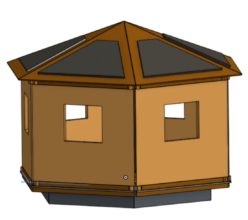Summary
The easiness of assembling and disassembling a construction brings in a new technical approach to prove the so called load bearing capacity. In classical engineering this proof of security is done by calculation.
With a reconstructable construction you can test and measure the stability and resilience for static and dynamic stress and thus show and prove the usability of a construction.
This is a great shift in construction from assumption to verficiation as described in detail below.
Calculation – the classical approach
The load bearing capacity of a construction in classical engineering is done by static calculations based on Standards like ASTM, EN, ISO etc. The standards were created by experts based on test results of standard units.
This approach was a big improvement as today building rarely crash due to insufficient dimensioning. But there are also some short comings. The algorithms are based on testing on basic assumptions and tests from standard elements. For new elements and construction that don’t match the basic assumptions the algorithms do not really apply. This is partially resolved by the introduction of safety factors.
The problem of this approach is that on one side you typically use too much material to satisfy the safety factor and uncertainty. On the other hand for complex structures you are not really sure how well the models match the reality of a particular construction.
The only way to prove the real usability is to stress a construction to the limit as it is done eg in the automotive industry when crashing cars against wall to find the deformations.
With real buildings this is not feasible as already higher stress below the load limit would significantly reduce the strength of a building. This is an issues since most buildings today both builder and architects are aiming for individual constructions that cannot get compared 1:1 to any parent or sibling construction.
For the basic construction of the reconstructable house for instance most algorithms of the norms don’t match because they are based on tests of either homogeneous elements or concrete elements. For the kind of reinforced wood there are no tests and it also does not make sense to start doing so because on one hand the construction is in process of continuous improvement and in addition we don’t need the results of isolated elements when we can stress and judge the construction as a whole. Why this is the case you will find in the next paragraph.
Test and verify – the new paradigm
If a construction is easy to assemble and disassemble you can test every part down to smallest detail to verify stability and improve the construction.
This improvement has 3 dimensions.
Proof usability before commercial installation
The basic model can be built, stressed and even crashed as many times as needed to verify the stability and service performance with real test and measurement results.
This is what we do with the reconstructable house. We first create models to estimate suitability for static and dynamic load. But the potential of testing the models is even greater. It allows to reproduce and judge the ease of assembly and security of construction. For the hexagonal model we created more then six models. The stability was reached by the first model. However the assembly was yet to complicated and there were severe security concerns.
Assert suitability during usage
All reconstructable house models are designed to be continuously testable and maintainable. This allows periodic controls and replacement of parts whenever needed.
This fact offers a new perspective for housing: It will be possible to offer a stable functional building for any period of time. This will allow to change from buying to a kind of leasing for a specific amount of time.
Test elements after usage
The completely new dimension is the possibility to test the impact of time and usage at the end of the life cycle, that is when the building is disassembled. As any part can be safely restored instead of being demolished, it is also possible to test every part at the end and find areas for improvement.
In classical construction the only way to build a house on the place of a concrete or stone house is to demolish the old one it. (It would be technically possible to saw it up, but nobody is willing and even interested to do – and pay – that.
With a reconstructable construction this becomes already part of the design process where we define a test and quality assurance procedure for the model.
This is turned into a business process to be applied at the end because you must execute a check of all parts after disassembling if you intend to reuse it in the next building. In addition
In short: you can test the quality of the building in the beginning and at the end. If ever there is a major concern that the stability could have been reduced, for instance after a heavy earth quake, the house can be quickly replaced by a new one to eliminate all fear of hidden damages. And the material can be analyzed to analyze the effect of extreme stress.
